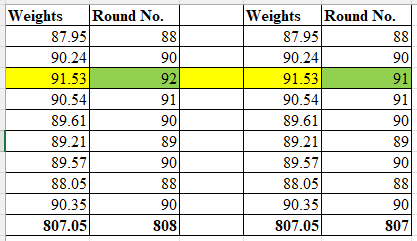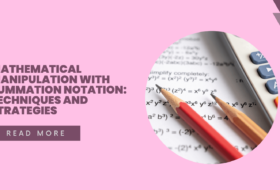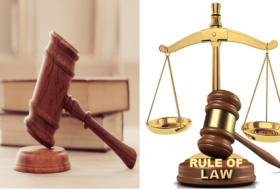Rounding is a systematic way of simplifying a number while keeping its value close to the original. It is a mathematical operation that is used to write a number in its simpler form.
To round a number means to rewrite the original number in a simple form with a slight deviation.
The number rounded has a nearby value to the original and is easy to understand.
The round number is used in many fields like engineering, science, finance, the stock market, etc.
This article will introduce rounding numbers and the methods. If you are in any way confused about how to round numbers, continue reading.
Table of Contents
What are Rounding Numbers?
Rounding a number is a systematic way of approximating the value of a such number. It is a way of rewriting the number so that the value stays close to the original value.
When you round a number, the final result is usually less accurate, but easier to use in computations.
For example, the final weights of 5 loaves of bread recorded by the quality control officer in grams are:
87.95, 90.24, 89.7, 88.05, and 90.35.
To easily calculate the average weight, we can convert the weights to the nearest whole number as follow:
88, 90, 90, 88, and 90.
Looking at the above round numbers you see that they deviate from the original value but are easy to compute.
Thus, rounding numbers are the simplest approximates of very large and small numbers. The process of approximating a number to its nearest number is known as rounding.
In the real world, we can perform rounding for those numbers for which the exact values do not hold much importance. But when dealing with financial values, it’s not always the best option to round numbers except with large decimals.
For example, we can round the value of 2.0125861 to 2.0126 instead of just 2. This is because multiplying the 0.012586 by 1000000 will result in 12,586. So, rounding to 2 means that you are losing 12,586 per 1 million.
There are usually two ways to round a number: round up, and round down.
Round up
When rounding a number, we approximate a number depending on the value next to it. Values are on a scale of 0, 1, 2, to 9, and the value halfway is 5. When the value next to the round number is 5 and above, we can round up the number.
Thus, round-up means increasing the value of the round number if the next value is equal to or greater than 5. This is not a rule, it depends on the situation on the ground. But it is what people generally do.
Round down
On the other hand, round down is decreasing the value of the round number if the next value is less than 5.
In our examples, we shall be rounding up or down depending on the value next to the round number.
Please, note that rounding up or down is at your discretion. You can choose to round up or down to ensure that your data does not deviate completely from an actual value.
For example, look at the table of data below.

The sum of the first round-up deviated significantly from the actual value. But with the value in the green cell rounded down to 91, the sum became closer. So, choose whether to round up or down depending on the data accuracy you expect.
General rules for rounding numbers
There are acceptable rules that students should follow when rounding numbers. But an independent worker can choose his/her rules based on his/her discretion.
The general rules to be followed are as follows:
- Determine the round number calculation. Is it to the nearest ten or tenth, whole number or hundred, etc.
- Based on the above, locate the rounding digit in the number to be rounded. For example, to round the number 752 to the nearest ten, the rounding digit is 5. To the nearest hundred, the rounding digit is 7.
- Haven identified the rounding digit, look at the value next (to the right) to the rounding digit. This value will determine whether you should round up or down
- If the value next to the rounding digit is equal to or greater than 5, round up. This implies that the rounding digit will increase by 1. If the value is less than 5, round down. This means the rounding digit will remain the same.
- Finally, whether you are rounding up or down, the values after the rounding digit will become zero (0).
How to Round Numbers
Rounding numbers is easy if you understand the basics. In this section, you will learn the basics of rounding numbers.
In number counting we begin from 1 and count to 10, then 100, 1000, and continuously. Thus, we have ones, tens, hundreds, thousands, ten thousand, hundred thousand, million, billion, and trillion.
Likewise, in places where decimals are represented, we have tenths, hundredths, thousandths, ten thousandths, hundred thousandths, millionths, billionths, and trillionths. Where the tenth is the inverse of ten, etc.
Naturally, Ones, tens, etc, and tenths, hundredths, etc are represented in the table below. Where the tenths, and hundredths represent the decimal or fractional part of a number.

Consider the following example. The total sales of Ucheson & Sons for the month of January 2023 were 12,355,468.6523.
Let us represent the above in a table for clarity.

The above table shows a typical way to represent a number for onward rounding.
Values to the left of the decimal are ones, tens, etc, and values to the right are tenths, hundredths, etc.
Based on the above, you can round whole numbers to the nearest ten, hundred, thousand, etc. However, decimals are rounded to the nearest tenth, hundredth, etc.
Though you can easily round numbers using a rounding numbers calculator, you should know how to round numbers. In this section, you’ll learn some of the methods of rounding numbers.
How to round off decimals
A decimal number is made up of two parts. The whole number part and the fractional part. The decimal point separates these two parts.

The decimal part is the numbers to the right of the decimal point. They are usually rounded off in tenths, hundredths, thousandths, etc.
To round off decimals, the same rules explained above apply. For example, round off 78.257 to the nearest hundredth.
The answer is 78.26. (Since 7 is greater than 5, we increase the rounding digit by 1).
Rounding numbers to the nearest whole number
To round a number to the nearest whole number means eliminating the fractional part of a decimal number.
To do this, abide by the rules explained above. That is, determine the rounding digit and check whether to round up or down.
For example, rounding 78.257 to the nearest whole number will give you 78.
Rounding numbers to the nearest 10
When you think of the nearest ten, remember the chart displayed above to determine the rounding digit.
The nearest ten is a whole number with a single zero at the end. E.g. 10, 40, 7510, etc. Hence, the ones placeholder will be converted to zero. It then means that the fractional part of a decimal number will be converted to zeros.
For example, to convert the number 78.257 to the nearest 10, you’ll have 80.
Round numbers to the nearest 100
Just like the nearest 10, the nearest 100 leaves two zeros at the end. So, using the placeholder chart above, you can determine the rounding digit and either round up or down,
For example, to round the number 652410.25 to the nearest 100, we have the following result: 652400.00.
Rounding numbers to the nearest 1000
Using the idea of rounding numbers to the nearest 10 and 100, we can round numbers to the nearest thousand.
You’ll need to understand the placeholder chart to determine the rounding unit. Also, you should know how many zeros should be left at the end. Your guess is right, 1000, that is 3 zeros.
For example, to round the number 652410.25 to the nearest 1000, you should have 652000.
Rounding Numbers Examples
Let us discuss how to round numbers with a simple example so that you can have clearer knowledge.
Question
Oxlade Proclo LLC posted its financial report on its website. When comparing the results, the group managing director identified deviations between the hardcopy and the electronic reports. The table below is an excerpt of their sales for 6 months. Use it to answer the questions that follow.
| Month | Sales in $ |
| January | 58,764.25 |
| February | 78,654.45 |
| March | 105,423.05 |
| April | 95,015.00 |
| May | 152,470.55 |
| June | 87,265.10 |
- Convert the monthly sales to the nearest tenths
- Convert the monthly sales to the nearest thousand
- Total the original values and that of the nearest 1000. What is the difference?
Solutions
- Let’s first place the numbers in a placeholder chart as follow:

To convert to the nearest tenth, the table below shows the rounding digit in the yellow column.

The numbers to the right of the rounding digits in rows 1, 2, 3, and 5 are 5 and above. Thus, we add 1 to the rounding digits (that is, round up).
But the number to the right of the rounding digits in rows 4 and 6 are less than 5. Thus, we leave the value of the rounding digits the same.
Therefore, the table below shows the result of rounding to the nearest tenth.

The new sales report will become as follow:
| Month | Sales in $ |
| January | 58,764.30 |
| February | 78,654.50 |
| March | 105,423.10 |
| April | 95,015.00 |
| May | 152,470.60 |
| June | 87,265.10 |
- Here, we’ll convert to the nearest 1000. Like in the above solution, let’s place the numbers in a placeholder chart and identify the rounding digit. The table below shows the placeholders and rounding digits with a red border line.

The numbers to the right of the rounding digits in rows 1, and 2 are 5 and above. Thus, we add 1 to the rounding digits (that is, round up).
But the number to the right of the rounding digits in rows 3, 4, 5, and 6 are less than 5. Thus, we leave the value of the rounding digits the same (round down). We then convert all values to the right of the rounding digits to zero.
Therefore, the table below shows the result of rounding to the nearest thousand.

The new sales report will become as follow:
| Month | Sales in $ |
| January | 59,000.00 |
| February | 79,000.00 |
| March | 105,000.00 |
| April | 95,000.00 |
| May | 152,000.00 |
| June | 87,000.00 |
- Here, we sum up the two sales and subtract the results. The table below shows the result.

From the result obtained above, you’ll notice a deviation of $592.40 from the original sales report. However, rounded numbers are easier and simpler to calculate.
I believe that the above example has given you a clearer understanding of how to calculate round numbers.
Conclusion
Rounding numbers is a common mathematical operation that is used to approximate numbers in order to understand them easily. It is mostly used in scientific calculations where you’ll need to approximate experimental data to easily compare their values.
Students in primary and secondary schools should learn and understand them. Also, applicants, employees, and business owners should learn them.
Though it makes computations easy, its results deviate from the original. However, you can randomly round up and down values to arrive at a very close result.
The rounding numbers calculator makes these computations easy, but it’ll be great if you understand their calculations.
This tutorial discussed how to round whole numbers and decimal numbers; it is now your turn to respond.
I will want you to ask questions and make contributions with regard to rounding whole numbers and decimals. Have you used round numbers before, and in what circumstances? Please, use the comment box below and respond, and do not forget to share your experiences.




